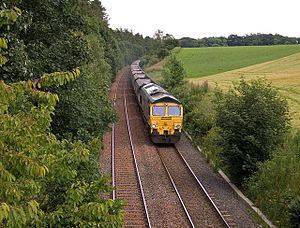Type Heavy rail, Rural Rail Status Operational | Stations 26 | |
 | ||
Locale ScotlandNorth West England | ||
The Glasgow South Western Line is a mainline railway in Scotland that runs from Glasgow to Kilmarnock, and then either Carlisle via Dumfries, or Stranraer via Ayr, with a branch to East Kilbride.
Contents
History
The line was built by several railway companies during the 19th century:
The Glasgow, Dumfries and Carlisle Railway and the Glasgow, Paisley, Kilmarnock and Ayr Railway amalgamated to form the Glasgow and South Western Railway in 1850.
The Glasgow, Barrhead and Neilston Direct Railway and Glasgow and Kilmarnock Joint Railway were amalgamated to form the Glasgow, Barrhead and Kilmarnock Joint Railway jointly operated by the Glasgow and South Western Railway and Caledonian Railway.
The lines forming the East Kilbride branch were operated by the Caledonian Railway.
Until 1923 the line via Dumfries was in competition with the North British Railway and Caledonian Railway as one of the mainlines into Scotland. With the passing of the Railways Act 1921 (Grouping Act) the line became part of the London, Midland and Scottish Railway (LMS).
In 1948, with nationalisation the line became part of the Scottish Region of British Railways. During the Beeching Axe in the 1960s many of the railway's branch lines were closed, including the direct route between Dumfries and Stranraer, via Galloway on the Portpatrick and Wigtownshire Joint Railway and Castle Douglas and Dumfries Railway, leaving the present 'Y' shaped railway. The former G&SWR terminus at Glasgow St Enoch was also closed in this period (in 1966), with all services rerouted into Glasgow Central.
During the electrification of the West Coast Main Line in the early 1970s by British Rail, the line was used as a major diversionary route whilst the Caledonian Railway's Annandale/Clydesdale route was closed, particularly during the weekends. Following completion of this project, the sections of line between Barrhead and Kilmarnock (with a crossing loop at Lugton) and Annan and Gretna (controlled from Carlisle) were singled. Re-doubling of the Annan to Gretna section was completed in August 2008, controlled from Dumfries Station signal box.
The line is not electrified, with the exception of parts of the line around the approaches to Glasgow Central and the section of the line (Barassie to Ayr) shared with the Ayrshire Coast Line (Ayr to Glasgow via Kilwinning). In early 2009, work commenced to re-double the line between Lugton and Stewarton based on the 2008 plans published by Network Rail. Completed in September 2009, this allows ScotRail to run a half-hourly service to Kilmarnock.
Accidents and incidents
Route
Trains serve the following stations.
Services
In the latter years of British Railways, operations were sectorised. All Scottish operations (excluding the WCML and ECML services), including this line, became part of the Regional Railways operation - being branded as ScotRail.
Following privatisation, passenger services upon the line were taken over by ScotRail, (part of National Express), and are now operated by Abellio ScotRail with the track and signalling being operated (nationally) by Network Rail. The Dumfries route remains one of only three railway lines between the Scottish border and lowland areas alongside the East Coast Main Line and West Coast Main Line. Along with the Settle-Carlisle Railway, the line is much used as both a diversionary route, especially during the recent West Coast Main Line modernisation, and for freight, notably coal from the several open cast coalmines of the Ayrshire Coalfield that adjoin the line.
Between Glasgow Central and Gretna Green and Girvan the line is operated by the Scottish Train Operating Company (TOC) - currently ScotRail. Electric train services are also provided between Glasgow and Troon and Ayr via the Ayrshire Coast Line. Some services continue on from Carlisle to Newcastle, though the daily direct services between Newcastle and Stranraer via Kilmarnock that once ran over the route were withdrawn in December 2009. There are also a number of through services between Glasgow & Stranraer that run direct via Paisley & Kilwinning (others run via Kilmarnock, as do certain trains to/from Girvan). From the December 2015 timetable change, new Scotrail franchisee Abiello has changed the timetable on the Stranraer line - the service frequency to/from Ayr has increased from six trains each way to nine on weekdays (and three to five on Sundays), but there are now no longer any direct trains to Glasgow via Paisley - all services now run via Kilmarnock.
In the 1970s, most of the intermediate stations between Kilmarnock and Carlisle were closed, leaving only Kirkconnel, Dumfries and Annan. Since then, the stations at New Cumnock, Auchinleck, Sanquhar and Gretna Green have been reopened. There have been several studies recently as to the possibility of reopening Thornhill station, roughly halfway between Dumfries and Sanquhar.
Rail & Sea Connections
The Glasgow South Western Line links into the ferries at Stranraer via the bus connecting with Cairnryan for the Stena Line ferries to the Port of Belfast and the P&O Ferries to Larne Harbour. The Stena Line ships (previously Sealink) ran from Stranraer Harbour until 2011. A bus connection to Cairnryan is also now provided from Ayr. Onward rail connections are provided by Northern Ireland Railways.
Former Ferries
The line also connected Troon to the P&O Ferries service to Larne Harbour.
